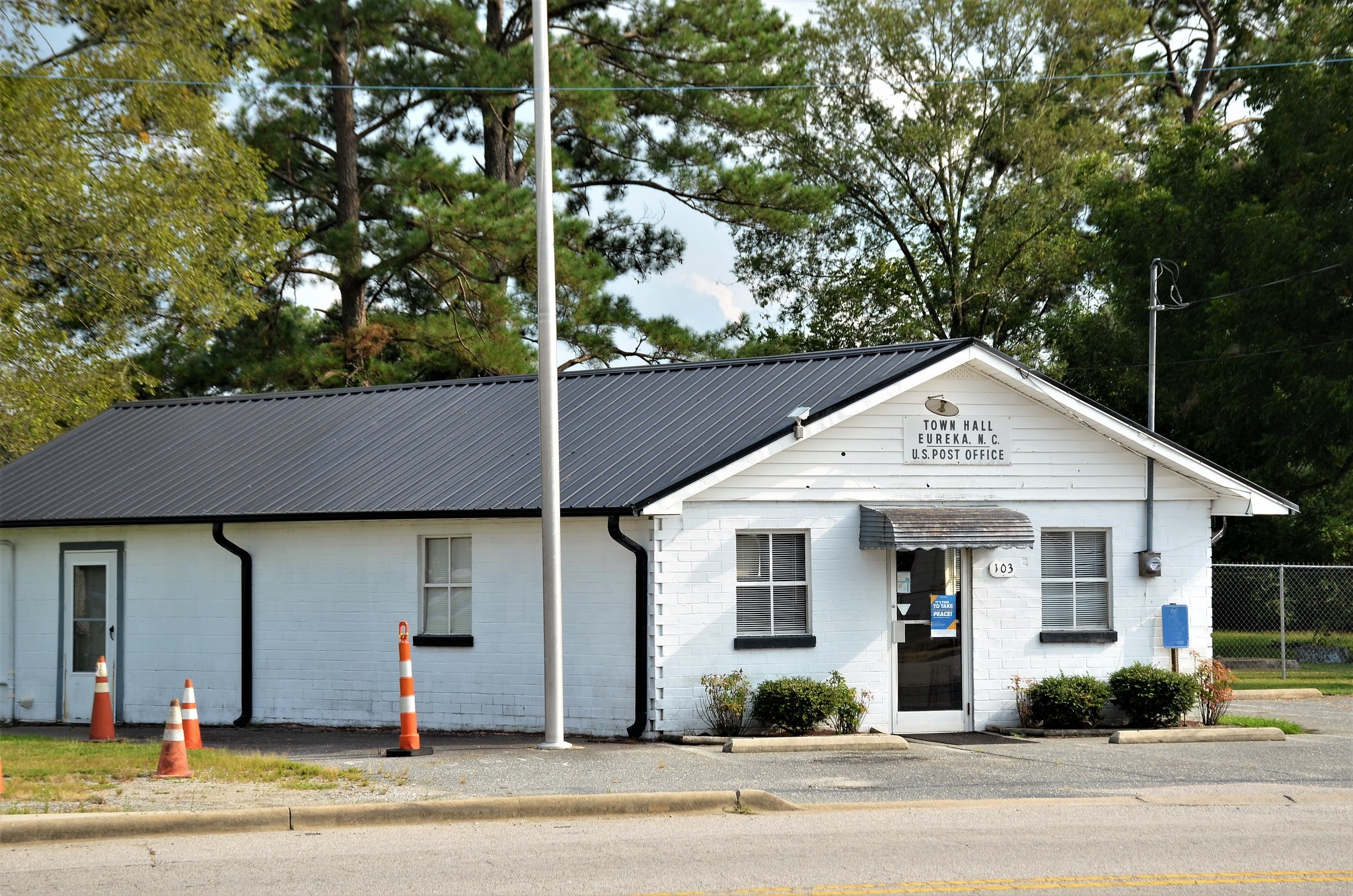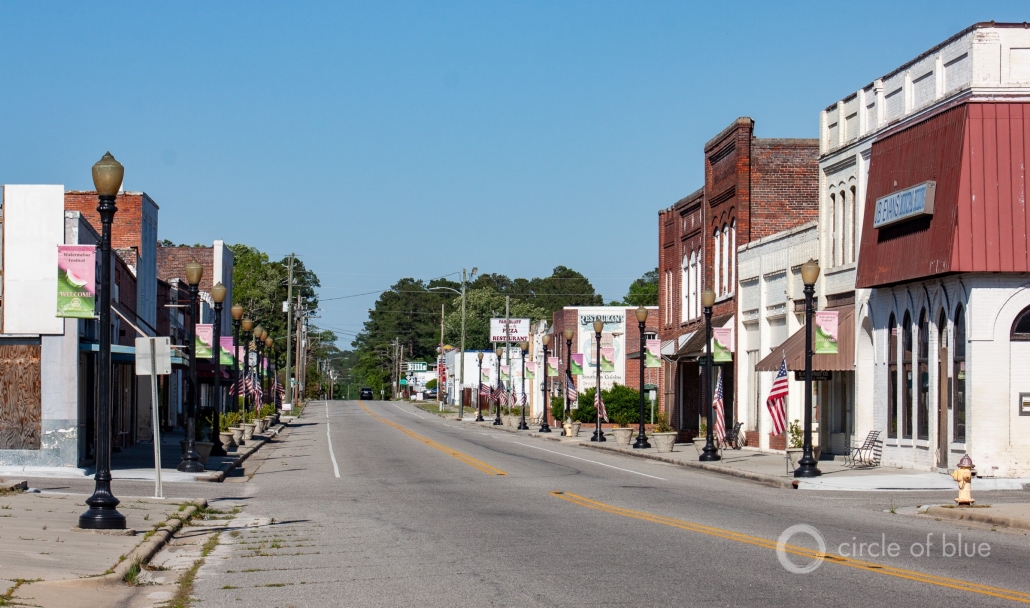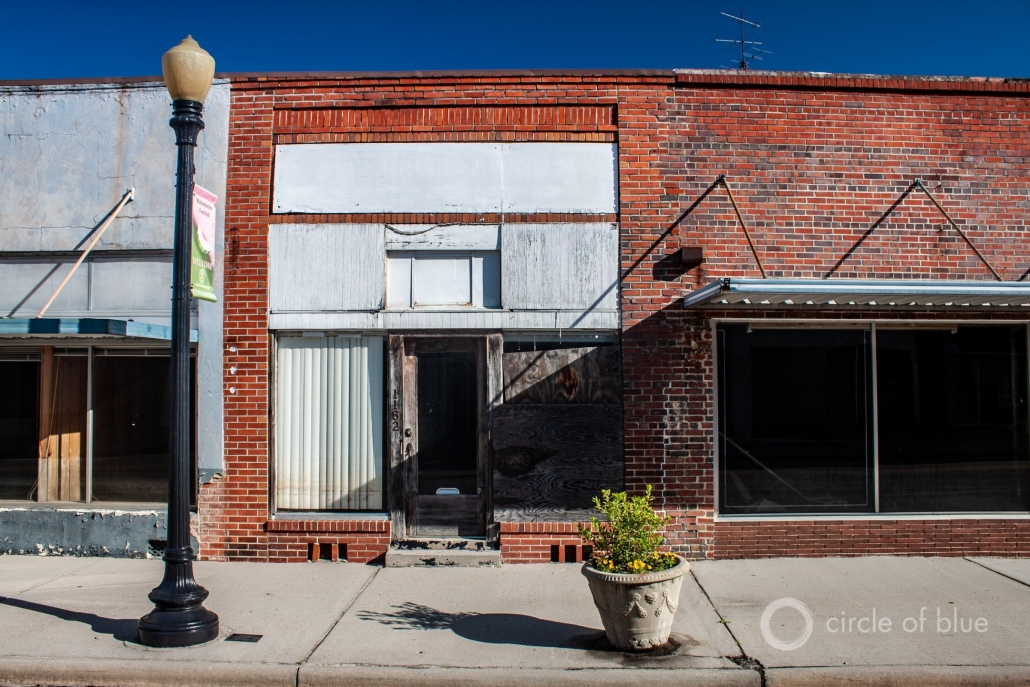State confronts challenge of affordable, reliable sewer service for some of its poorest communities.

North Carolina authorities took control of Eureka’s finances three months ago because the sewer system was bankrupting the town. Photo © Earl C. Leatherberry
By Brett Walton, Circle of Blue
October 17, 2019
Rising sewer bills, a result of inadequate infrastructure and heavy rainfall, are driving small, rural communities in North Carolina toward bankruptcy.
Dozens of small towns are running chronic budget deficits in their sewer system operations. These towns are challenged by aging and declining populations, low incomes, and sewer rates that are already some of the highest in the state. State officials say that economic hardship, deficient infrastructure, and an inability to manage and maintain delicate engineering systems have contributed to the stirrings of a rural financial crisis rooted in public sewer system failures.
The Local Government Commission, a state agency that oversees local finances, took the historic step in July of suspending the charter of Eureka, a town of 197 people on the coastal plain. The five-year suspension, a seldom-used option for addressing financial disarray, gives the state control of the town’s budget.
For at least a decade, Eureka has run annual deficits in its sewer fund, Sharon Edmundson, director of the fiscal management section of the State Treasurer’s State and Local Government Finance Division, told Circle of Blue. Transfers from the general fund kept the sewer system afloat, but now even the general fund is at risk of depletion.
“Eureka was in a situation where they had more payables than assets to pay them,” said Edmundson, who is now acting as the town finance officer and is responsible for budget decisions. “So the commission took action.”
It is the first time, to Edmundson’s knowledge, that the commission has suspended a town charter because of chronic sewer system debt.
Sewer system budget deficits have caught the eye of state authorities and legislators, who are committing grant funds to rescue Eureka and to head off problems in other small towns and service providers that live on the edge of financial viability. Another top priority for the commission is Cliffside Sanitary District, which serves 84 sewer customers in the Appalachian foothills.
“There’s just no margin of error financially,” Kim Colson, director of the Water Infrastructure Division of the Department of Environmental Quality, told Circle of Blue about these small communities. “They don’t have the customer base to not have everything go exactly right and to stay financially sustainable.”
Eureka, One of Many
While Eureka might be the first town in the state in this position, it is not the only small community where inadequate water infrastructure is breaking the budget.
One hundred towns are on a state financial watch list, Edmundson said. Roughly two-thirds made the list because of indebted sewer systems, and 37 of the sewer systems are rated a high financial risk. Many have trouble surviving on their own. Fair Bluff, which landed on the list because of frequent sewer deficits, is relying on state and federal grants to repair its aging, leaking system. The town was flooded by hurricanes twice in three years and its population is down by a third since then.
“Eureka is definitely not a one-off situation,” Edmundson said.
Eureka’s crisis springs from the juncture of economics, engineering, and hydrology. Residents pay their monthly sewer bill based on the amount of water they use at home. But the pipes that carry sewage to the treatment facility are vulnerable to infiltration of groundwater and rainwater, through cracks and fissures in the lines. A financial mismatch arises: the town has to pay to treat the invading water, but it gets no revenue for it.
In Eureka’s case, infiltration can be massive, especially when it rains. Budget numbers illustrate the crippling imbalance. Average revenue from sewer charges is between $7,500 and $8,000 per month, Edmundson said. The cost of sewage treatment — water flushed down drains plus additional rainwater and groundwater — can range from $8,500 in a really dry month to as much as $33,000 in a really wet month.
“You can see the gap there,” Edmundson quipped.
Authorities are eager to ward off a complete financial failure in Eureka because it could result in an undesirable domino effect. That is because Eureka sends its wastewater to Fremont, a slightly larger neighbor, for treatment. This partnership produces two problems for Fremont: excess water and late payments.
Fremont treats wastewater by putting it in a lagoon temporarily, then spraying the effluent on a designated field. The state caps the amount of spraying at 100,000 gallons a day in summer and 53,000 gallons a day in winter.
When Fremont exceeds its spray field capacity, it sends the surplus to another town, Goldsboro, at higher cost, according to Barbara Aycock, town administrator for Fremont. All the infiltration from Eureka causes Fremont to exceed its spraying limit more often than it likes, she said.
Eureka also lacks a debris-trapping basket in the lift station that facilitates the movement of wastewater, Aycock said. Without a basket, plastic bags, rags, and other items wind up in Fremont’s system and prematurely age the equipment that is designed to grind them up.
“We’re faced with the big expense to repair pumps because of their problem,” Aycock told Circle of Blue. “It caused our town to be financially stressed.”
Eureka’s union with Fremont dates to 1999, when a state grant facilitated the connection. Eureka operated a small lagoon of its own for which it did not have adequate staffing, Aycock said.
But as Eureka’s financial troubles grew, the partnership slowly unraveled. “No one imagined the problem would be as big as it was,” Aycock reflected.
Fremont itself is on the Local Government Commission’s financial watch list. The town has run a deficit in its sewer system for the four and half years that Aycock has been on the job. Transfers between other town funds prop up the sewer system’s finances. “The water fund is what is supporting the sewer fund,” she said.
Aycock said that her community, which has some of the highest sewer rates in the state, would struggle to pay for upgrades on its own. Sewer rates are $10.97 per 1,000 gallons, plus a fixed monthly fee of $20.90. For a family using 5,000 gallons per month, a typical benchmark, the bill ($75.75) would be higher than that in Seattle, which has one of the country’s highest big city sewer rates. Eureka residents pay even more: $99.05 per month for 5,000 gallons.
“If you keep raising rates, you’re not going to have a population anymore because people can’t afford to live here,” Aycock said. Residents served by Fremont who live outside the town limits are even more pinched. Their rates are double the in-town rates.
Colson, of the Water Infrastructure Division, is also sensitive to the fact that sewer rates in these communities may be approaching a ceiling.
“Affordability is a big question right now with respect to water bills now across the county,” Colson said. “If your sewer bill needs to be $120 a month and that’s just sewer, it’s getting into an area where it’s just not competitive. Then even more people leave the town and they’re facing a more significant revenue crisis and that’s not sustainable.”
These towns are already shrinking, a demographic decline that places the burden of maintaining the system on the shoulders of fewer people. Eureka’s population peaked in 1980 at 303. The Census Bureau estimates the current population at 197.
Fremont has also experienced a decline. The town shrank from 1,736 people in 1980 to an estimated 1,265 last year.
Edmundson said that small towns, many with declining populations and only several hundred residents, are a common factor for the financial watch list.
Mounting Pressures
The hydrological pressures on rural sewer systems are also not likely to relent. North Carolina is expected to see more severe downpours and higher overall precipitation as the planet warms, according to a federal climate change assessment. A separate analysis of 19 coastal wastewater treatment facilities in North Carolina identified significant vulnerabilities to increased rainfall and seasonally high groundwater tables, which can also infiltrate sewer pipes. Adding to the difficulty is that many of the state’s clay soils do not drain well.

An abandoned business on Main Street in Fair Bluff, North Carolina. The town, which is struggling to recover from two floods and a declining population, is on the Local Government Commission’s financial watch list because of a failing sewer system. Photo © Brett Walton/Circle of Blue
The short-term fix is to patch budget holes through a variety of cash swaps. Edmundson’s 2019-20 budget for Eureka includes a transfer of $90,993 from the general fund to the sewer fund. These transfers are frowned upon for budget managers, Edmundson said. But they can be an option of last resort.
Even after the general fund transfer, the 2019-2020 budget projected a nearly $120,000 deficit in the sewer fund.
Eureka is also squaring its debt with Fremont. On October 14, Edmundson mailed a check for roughly $29,000 to cover the past-due balance. That money came from a $25,000 Department of Commerce grant and a $200,000 State Water Infrastructure Authority grant. The remainder of the Infrastructure Authority grant is being held in reserve to pay future bills.
The Infrastructure Authority grant is part of an emergency funding program authorized last month by the General Assembly. Senate Bill 691 allows the state to provide grant funds to cover operating deficits for utilities that have been taken over by the Local Government Commission or had their charter revoked.
That the bill’s language mirrors Eureka’s circumstances is not a coincidence. The bill’s sponsor, Sen. Jim Perry, a Republican, represents the area.
Looking Forward
Because of the financial, hydrological, and demographic headwinds, Colson and other officials, guided by a master plan published in 2017, are exploring new paths for small sewer systems.
One option is to merge a failing utility with a better managed neighbor. Authorities in California and Kentucky have taken this path with struggling water and sewer systems in those states. But the mergers have to be done in a way that avoids the problems that surfaced in the Eureka-Fremont partnership, where, instead of strength in numbers, it was weakness in union.
“If you have a larger system willing to look at consolidation with a struggling system, you can’t penalize their customers,” Colson explained. “So you have to make them whole at the beginning. That can require a substantial amount of funding to make that happen.”
Colson is also using grant funding to help utilities assess the feasibility of mergers. The goal of this upfront planning is to foster viable utilities that can raise sufficient revenue to maintain, operate, and invest in their water and sewer systems.
For towns that operate them, a functioning sewer system is an asset that cannot be overlooked, Edmundson said. Eureka’s sewer hardship, for instance, limits the town’s financial flexibility.
“Right now, the general fund is depleted,” she said. “If an emergency were to come up, they would not have the funds to address it.”
Related: Brett Walton’s In-Depth Coverage of Fair Bluff
After Fair Bluff Flooded
Flooded by hurricanes twice in three years, the small town of Fair Bluff, North Carolina, is a poster child for the devastation of powerful, slow-moving storms.
The town’s struggle to recover from those storms reflects demographic, economic, and technological changes that are eroding small communities across rural America.
Brett writes about agriculture, energy, infrastructure, and the politics and economics of water in the United States. He also writes the Federal Water Tap, Circle of Blue’s weekly digest of U.S. government water news. He is the winner of two Society of Environmental Journalists reporting awards, one of the top honors in American environmental journalism: first place for explanatory reporting for a series on septic system pollution in the United States(2016) and third place for beat reporting in a small market (2014). He received the Sierra Club’s Distinguished Service Award in 2018. Brett lives in Seattle, where he hikes the mountains and bakes pies. Contact Brett Walton








